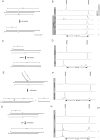DNA uracil repair initiated by the archaeal ExoIII homologue Mth212 via direct strand incision
- PMID: 19240141
- PMCID: PMC2673441
- DOI: 10.1093/nar/gkp102
DNA uracil repair initiated by the archaeal ExoIII homologue Mth212 via direct strand incision
Abstract
No genes for any of the known uracil DNA glycosylases of the UDG superfamily are present in the genome of Methanothermobacter thermautotrophicus DeltaH, making it difficult to imagine how DNA-U repair might be initiated in this organism. Recently, Mth212, the ExoIII homologue of M. thermautotrophicus DeltaH has been characterized as a DNA uridine endonuclease, which suggested the possibility of a novel endonucleolytic entry mechanism for DNA uracil repair. With no system of genetic experimentation available, the problem was approached biochemically. Assays of DNA uracil repair in vitro, promoted by crude cellular extracts, provide unequivocal confirmation that this mechanism does indeed operate in M. thermautotrophicus DeltaH.
Figures




Similar articles
-
Archaeal DNA uracil repair via direct strand incision: A minimal system reconstituted from purified components.DNA Repair (Amst). 2010 Apr 4;9(4):438-47. doi: 10.1016/j.dnarep.2010.01.004. Epub 2010 Feb 2. DNA Repair (Amst). 2010. PMID: 20129830
-
The Methanothermobacter thermautotrophicus ExoIII homologue Mth212 is a DNA uridine endonuclease.Nucleic Acids Res. 2006;34(18):5325-36. doi: 10.1093/nar/gkl604. Epub 2006 Sep 29. Nucleic Acids Res. 2006. PMID: 17012282 Free PMC article.
-
Crystal structure analysis of DNA uridine endonuclease Mth212 bound to DNA.J Mol Biol. 2010 Jun 18;399(4):604-17. doi: 10.1016/j.jmb.2010.04.044. Epub 2010 Apr 29. J Mol Biol. 2010. PMID: 20434457
-
Envisioning the molecular choreography of DNA base excision repair.Curr Opin Struct Biol. 1999 Feb;9(1):37-47. doi: 10.1016/s0959-440x(99)80006-2. Curr Opin Struct Biol. 1999. PMID: 10047578 Review.
-
Pocketing the difference: structures of uracil excision repair proteins.Chem Biol. 1995 Jun;2(6):351-4. doi: 10.1016/1074-5521(95)90213-9. Chem Biol. 1995. PMID: 9383436 Review.
Cited by
-
A novel endonuclease that may be responsible for damaged DNA base repair in Pyrococcus furiosus.Nucleic Acids Res. 2015 Mar 11;43(5):2853-63. doi: 10.1093/nar/gkv121. Epub 2015 Feb 18. Nucleic Acids Res. 2015. PMID: 25694513 Free PMC article.
-
Evolutionary Origins of DNA Repair Pathways: Role of Oxygen Catastrophe in the Emergence of DNA Glycosylases.Cells. 2021 Jun 24;10(7):1591. doi: 10.3390/cells10071591. Cells. 2021. PMID: 34202661 Free PMC article. Review.
-
Helix-hairpin-helix protein MJ1434 from Methanocaldococcus jannaschii and EndoIV homologue TTC0482 from Thermus thermophilus HB27 do not process DNA uracil residues.Nucleic Acids Res. 2010 Aug;38(15):5119-29. doi: 10.1093/nar/gkq270. Epub 2010 Apr 21. Nucleic Acids Res. 2010. PMID: 20410075 Free PMC article.
-
Haloferax volcanii-a model archaeon for studying DNA replication and repair.Open Biol. 2020 Dec;10(12):200293. doi: 10.1098/rsob.200293. Epub 2020 Dec 2. Open Biol. 2020. PMID: 33259746 Free PMC article. Review.
References
-
- Lindahl T. Instability and decay of the primary structure of DNA. Nature. 1993;362:709–715. - PubMed
-
- Dianov G, Lindahl T. Reconstitution of the DNA base excision-repair pathway. Curr. Biol. 1994;4:1069–1076. - PubMed
-
- Sartori AA, Jiricny J. Enzymology of base excision repair in the hyperthermophilic archaeon Pyrobaculum aerophilum. J. Biol. Chem. 2003;278:24563–24576. - PubMed
MeSH terms
Substances
Grants and funding
LinkOut - more resources
Full Text Sources
Molecular Biology Databases

